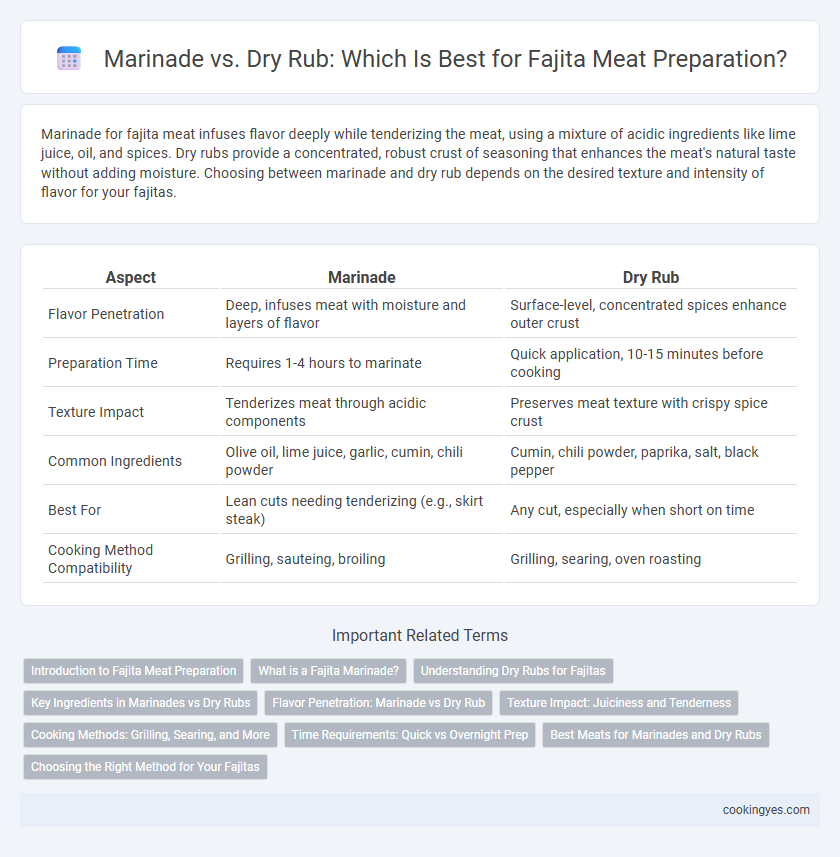Marinade for fajita meat infuses flavor deeply while tenderizing the meat, using a mixture of acidic ingredients like lime juice, oil, and spices. Dry rubs provide a concentrated, robust crust of seasoning that enhances the meat's natural taste without adding moisture. Choosing between marinade and dry rub depends on the desired texture and intensity of flavor for your fajitas.
Table of Comparison
| Aspect | Marinade | Dry Rub |
|---|---|---|
| Flavor Penetration | Deep, infuses meat with moisture and layers of flavor | Surface-level, concentrated spices enhance outer crust |
| Preparation Time | Requires 1-4 hours to marinate | Quick application, 10-15 minutes before cooking |
| Texture Impact | Tenderizes meat through acidic components | Preserves meat texture with crispy spice crust |
| Common Ingredients | Olive oil, lime juice, garlic, cumin, chili powder | Cumin, chili powder, paprika, salt, black pepper |
| Best For | Lean cuts needing tenderizing (e.g., skirt steak) | Any cut, especially when short on time |
| Cooking Method Compatibility | Grilling, sauteing, broiling | Grilling, searing, oven roasting |
Introduction to Fajita Meat Preparation
Marinating fajita meat involves soaking strips of beef, chicken, or shrimp in a mixture of citrus juices, garlic, and spices to tenderize and infuse bold flavors. Dry rubs use a blend of ground spices such as cumin, paprika, chili powder, and garlic powder to coat the meat, creating a robust crust during cooking. Choosing between marinade and dry rub affects texture and taste, with marinades enhancing moisture and dry rubs intensifying savory notes on fajita beef or chicken.
What is a Fajita Marinade?
A fajita marinade is a flavorful liquid mixture typically composed of citrus juice, oil, garlic, and spices, designed to tenderize and infuse the meat with bold, zesty flavors. It penetrates the meat fibers, enhancing juiciness and ensuring a well-balanced taste that complements the charred, smoky profile of grilled fajita meat. Compared to dry rubs, marinades provide moisture and deeper flavor absorption, making them ideal for tougher cuts like skirt or flank steak used in traditional fajitas.
Understanding Dry Rubs for Fajitas
Dry rubs for fajitas concentrate bold spices like paprika, cumin, chili powder, garlic powder, and salt to create a flavorful crust that enhances the meat's natural juices during cooking. Unlike marinades, which involve soaking the meat in liquids for extended periods, dry rubs quickly infuse surface flavor, making them ideal for tender cuts like skirt or flank steak. This technique intensifies the sear and produces a caramelized exterior, resulting in a rich, smoky taste characteristic of authentic fajita meat.
Key Ingredients in Marinades vs Dry Rubs
Marinades for fajita meat typically include key ingredients such as citrus juices (lime or orange), oil, garlic, and chili powder, which tenderize and infuse the meat with moisture and tangy flavor. Dry rubs rely on a blend of ground spices like cumin, paprika, chili powder, garlic powder, and salt to create a flavorful crust without adding liquid. Both methods enhance the taste, but marinades penetrate deeper whereas dry rubs offer a concentrated spice layer on the surface.
Flavor Penetration: Marinade vs Dry Rub
Marinades penetrate fajita meat deeply by breaking down muscle fibers with acidic ingredients like lime juice or vinegar, resulting in enhanced flavor infusion and tenderness. Dry rubs primarily season the surface, creating a flavorful crust but with limited internal flavor absorption. For maximum flavor penetration in fajitas, marinating is more effective than using a dry rub alone.
Texture Impact: Juiciness and Tenderness
Marinades for fajita meat enhance juiciness and tenderness by breaking down muscle fibers with acidic ingredients like lime juice and vinegar, allowing deeper flavor penetration and moisture retention. Dry rubs create a flavorful crust that adds texture but may not improve internal tenderness as effectively as marinades. Choosing marinades results in a softer, more succulent fajita meat, while dry rubs yield a firmer, slightly drier exterior with concentrated spice flavors.
Cooking Methods: Grilling, Searing, and More
Marinades tenderize fajita meat while infusing it with moisture and bold flavors, ideal for grilling and slow searing to develop char and caramelization. Dry rubs create a flavorful crust by concentrating spices directly on the meat surface, perfect for high-heat searing and quick grilling that locks in juices. Both methods enhance the fajita experience, with marinades promoting tenderness and dry rubs emphasizing texture and spice intensity.
Time Requirements: Quick vs Overnight Prep
Marinades for fajita meat typically require overnight soaking, allowing acids and spices to tenderize and deeply flavor the meat, enhancing juiciness and tenderness. Dry rubs offer a quicker preparation, usually applied just before cooking, providing a concentrated burst of flavor without the extended wait time. Choosing between marinade and dry rub depends on available preparation time and desired flavor intensity in fajita dishes.
Best Meats for Marinades and Dry Rubs
Chicken breast, skirt steak, and flank steak are ideal for marinades because their lean fibers absorb flavors and tenderize well. For dry rubs, thicker cuts like chuck roast or brisket hold spices on the surface, creating a robust crust without overwhelming the meat's natural texture. Choosing the right meat enhances the fajita's taste, balancing tenderness and seasoning intensity.
Choosing the Right Method for Your Fajitas
Marinades enhance fajita meat by infusing flavors deeply while tenderizing, using acidic ingredients like lime juice or vinegar combined with spices. Dry rubs create a concentrated crust, locking in juices and adding bold, smoky seasoning without extra moisture. Selecting between marinade and dry rub depends on desired texture and flavor intensity, with marinades offering moist, tender meat and dry rubs delivering a robust, caramelized exterior.
Marinade vs Dry rub for fajita meat preparation Infographic

 cookingyes.com
cookingyes.com